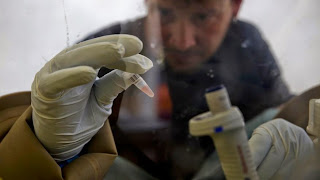Ebola first appeared more than three decades ago, but there is still no cure or specific treatment for the disease, in part because the dangerous nature of the virus makes it difficult to study, experts say.
People with Ebola are treated with only general therapies meant to support the ill patient. They might be given fluids (Ebola patients are frequently dehydrated), or treatments aimed at maintaining blood pressure and oxygen levels, and treating infections if they develop, according to the Centers for Disease Control and Prevention.
So why aren't there more specific treatments for Ebola?
Part of the reason is that Ebola is caused by a virus, rather than bacteria, and researchers in general have had a harder time developing treatments for viral diseases, compared with bacterial diseases, said Derek Gatherer, a bioinformatics researcher at Lancaster University in the United Kingdom who studies virus genetics and evolution.
"Antiviral therapy has lagged behind antibacterial therapy for decades," Gatherer said.
That's because viruses are small molecules that produce only a handful of proteins, so there are fewer "targets" for treatment, Gatherer said. For this same reason, it has been hard to develop a vaccine against Ebola; a person's immune system (which is primed by vaccines) has a small target, Gatherer said.
Ebola virusesalso evolve quite quickly, so it's not clear whether a vaccine developed today would protect against future outbreaks, he said. (Ebola viruses belong to a family of viruses called Filoviridae, and there are five known species of Ebola virus.)
And because the virus is so dangerous in some outbreaks, the mortality rate has been as high as 90 percent researchers must work with the virus in special facilities with high-level safety precautions, which limits the number of experiments that can be done.
"There's only a handful of places in the world were you can actually do Ebola experimentation," Gatherer said. Ebola viruses require a "biosafety level 4" laboratory the highest level of protection.
In addition, relatively few people have ever been infected with Ebola, and even fewer have survived, thus making it hard to study the virus in people or examine whether there are certain biological factors that help people survive, Gatherer said.
Ebola first appeared in 1976, in outbreaks in the Democratic Republic of Congo and Sudan. The origin of the virus is not known, but it is thought to reside in bats.
People become infected with Ebola through close contact with infected animals, and the virus spreads person-to-person through contact with bodily fluids, such as blood or secretions, according to WHO. Symptoms include fever, muscle pain and headache, followed by vomiting, diarrhea, rash and, in some cases, internal and external bleeding, WHO says.
TheEbola virus attacks immune cells, and can cause the immune system to run out of control and release a "storm" of inflammatory molecules, which cause tiny blood vessels to burst, Gatherer said. This blood-vessel damage can cause blood pressure to drop, and lead to multiple-organ failure, Gatherer said.
Some potential Ebola treatments show promise in animal models, including compounds that interfere with the way the virus replicates. Other experimental treatments aim to prevent the virus from entering cells, by blocking the proteins on the surface of cells to which the virus binds.
Another therapy in the works involves injecting mice with parts of the virus and using their antibodies to treat infection. In a 2012 study, four monkeys with Ebola survived the infection when they were given a combination of these antibodies one day after infection.
Source:foxnews

















0 comments:
Post a Comment